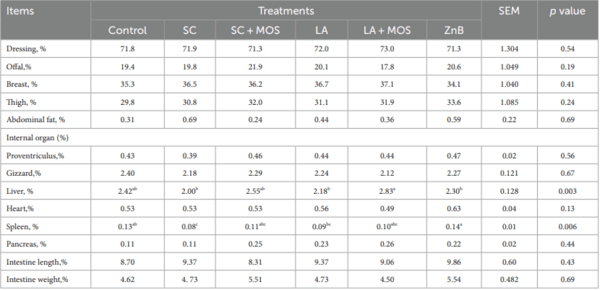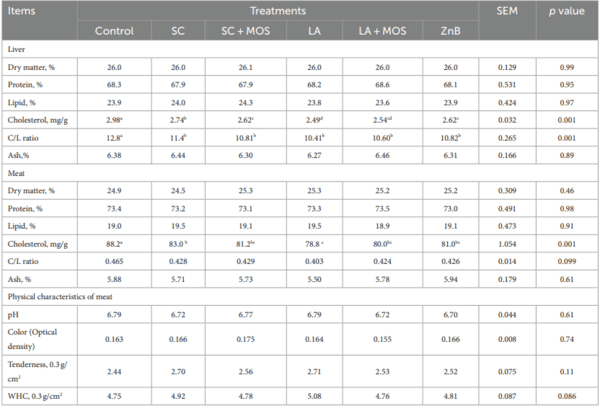Probiotics as alternatives to antibiotic growth promoters
Alternative to antibiotic growth promoters: beneficial effects of Saccharomyces cerevisiae and/or Lactobacillus acidophilus supplementation on the growth performance and sustainability of broilers’ production
Author details:





1. Castanon JIR. History of the use of antibiotic as growth promoters in European poultry feeds. Poult Sci. (2007) 86:2466–71. doi: 10.3382/ps.2007-00249
2. Hafez HM, Shehata AA. Turkey production and health: current challenges. Ger J Vet Res. (2021) 1:3–14. doi: 10.51585/gjvr.2021.0002
3. Van TTH, Yidana Z, Smooker PM, Coloe PJ. Antibiotic use in food animals worldwide, with a focus on Africa: pluses and minuses. J Glob Antimicrob Resist. (2020) 20:170–7. doi: 10.1016/j.jgar.2019.07.031
4. Engberg RM, Hedemann MS, Leser TD, Jensen BB. Effect of zinc bacitracin and salinomycin on intestinal microflora and performance of broilers. Poult Sci. (2000) 79:1311–9. doi: 10.1093/ps/79.9.1311
5. Thema K, Mlambo V, Snyman N, Mnisi CM. Evaluating alternatives to zinc bacitracin antibiotic growth promoter in broilers: physiological and meat quality responses. Animals. (2019) 9:1160. doi: 10.3390/ani9121160
6. Crisol-Martínez E, Stanley D, Geier MS, Hughes RJ, Moore RJ. Understanding the mechanisms of zinc bacitracin and avilamycin on animal production: linking gut microbiota and growth performance in chickens. Appl Microbiol Biotechnol. (2017) 101:4547–59. doi: 10.1007/s00253-017-8193-9
7. Shehata AA, Attia Y, Khafaga AF, Farooq MZ, El-Seedi HR, Eisenreich W, et al. Restoring healthy gut microbiome in poultry using alternative feed additives with particular attention to phytogenic substances: challenges and prospects. Ger J Vet Res. (2022) 2:32–42. doi: 10.51585/gjvr.2022.3.0047
8. Attia YA, Al-Hanoun A, El-Din AET, Bovera F, Shewika YE. Effect of bee pollen levels on productive, reproductive and blood traits of NZW rabbits. J Anim Physiol Anim Nutr. (2011) 95:294–303. doi: 10.1111/j.1439-0396.2010.01054.x
9. Andrew Selaledi L, Mohammed Hassan Z, Manyelo TG, Mabelebele M. The current status of the alternative use to antibiotics in poultry production: an African perspective. Antibiot Basel Switz. (2020) 9:594. doi: 10.3390/antibiotics9090594
10. Shareef AM, Al-Dabbagh ASA. Effect of probiotic (Saccharomyces cerevisiae) on performance of broilers chicks. Iraq J Vet Sci. (2009) 23:23–9.
11. Fooks LJ, Gibson GR. Probiotics as modulators of the gut flora. Br J Nutr. (2002) 88:S39–49. doi: 10.1079/BJN2002628
12. Ben Lagha A, Haas B, Gottschalk M, Grenier D. Antimicrobial potential of bacteriocins in poultry and swine production. Vet Res. (2017) 48:22. doi: 10.1186/ s13567-017-0425-6
13. Murry AC, Hinton A, Buhr RJ. Effect of botanical probiotic containing lactobacilli on growth performance and populations of bacteria in the ceca, cloaca, and carcass rinse of broiler chickens. Int J Poult Sci. (2006) 5:344–50. doi: 10.3923/ijps.2006.344.350
14. Abou El-Naga MK. Effect of dietary yeast supplementation on broiler performance. Egypt Poult Sci J. (2012) 32:95–106.
15. Onifade AA, Babatunde GM. Supplemental value of dried yeast in a high-fibre diet for broiler chicks. Anim Feed Sci Technol. (1996) 62:91–6. doi: 10.1016/S0377-8401(96)00991-1
16. Paryad A, Mahmoudi M. Effect of different levels of supplemental yeast Saccharomyces cerevisiae on performance, blood constituents and carcass characteristics of broiler chicks. Afr J Agric Res. (2008) 3:835–42.
17. Elghandour MMY, Khusro A, Adegbeye MJ, Tan Z, Abu Hafsa SH, Greiner R, et al. Dynamic role of single-celled fungi in ruminal microbial ecology and activities. J Appl Microbiol. (2020) 128:950–65. doi: 10.1111/jam.14427
18. Tuohy KM, Probert HM, Smejkal CW, Gibson GR. Using probiotics and prebiotics to improve gut health. Drug Discov Today. (2003) 8:692–700. doi: 10.1016/ s1359-6446(03)02746-6
19. Fairchild AS, Grimes JL, Jones FT, Wineland MJ, Edens FW, Sefton AE. Effects of hen age, bio-Mos, and Flavomycin on poult susceptibility to oral Escherichia coli challenge. Poult Sci. (2001) 80:562–71. doi: 10.1093/ps/80.5.562
20. Ballou CE. A study of the immunochemistry of three yeast Mannans. J Biol Chem. (1970) 245:1197–203. doi: 10.1016/S0021-9258(18)63307-121. Parks CW, Grimes JL, Ferket PR, Fairchild AS. The case for mannanoligosaccharides in poultry diets. An alternative to growth promotant antibiotics? Proceedings of Altech’s 16th annual symposium, Lyons, T.P. and Jacques, K.A.,. Nottingham, UK: eds. Nottingham University Press (2001). p. 45–59
22. Sonmez G, Eren M. Effects of supplementation of zinc bacitracin, mannan oligosaccharide and probiotic into the broiler feeds on morphology of the small intestine. Vet Fac Derg Uludag Univ. (1999) 18:125–38.
23. Pascual A, Pauletto M, Giantin M, Radaelli G, Ballarin C, Birolo M, et al. Effect of dietary supplementation with yeast cell wall extracts on performance and gut response in broiler chickens. J Anim Sci Biotechnol. (2020) 11:40. doi: 10.1186/s40104-020-00448-z
24. Cotter PF, Sefton AE, Liburn MS. Manipulating the immune system of layers and breeders: novel applications of mannan oligosaccharides In: Proc. Alltech’s Framingham State College, Alltech Canada, Ohio State University: Nottingham University Press (2000). 21–8.
25. Raju M, Devegowda G. Esterified-Glucomannan in broiler chicken diets contaminated with aflatoxin, ochratoxin and T-2 toxin: evaluation of its binding (in vitro) and efficacy as immunomodulator. Asian-Austral J Anim Sci. (2002) 15:1051–6. doi: 10.5713/ajas.2002.1051
26. Rashid S, Alsayeqh AF, Akhtar T, Abbas RZ, Ashraf R. Probiotics: alternative to antibiotics in poultry production. Int J Vet Sci. (2022) 10:45–53. doi: 10.47278/journal. ijvs/2022.175
27. NRC. Nutrient requirements of poultry. Ninth Revised ed. Washington D.C.: National Academy Press (1994).
28. A.O.A.C. Official methods of analysis. 16th ed. USA: Association of Official Analytical Chemists Washington, DC (1995).
29. Huff GR, Huff WE, Jalukar S, Oppy J, Rath NC, Packialakshmi B. The effects of yeast feed supplementation on Turkey performance and pathogen colonization in a transport stress/Escherichia coli challenge. Poult Sci. (2013) 92:655–62. doi: 10.3382/ ps.2012-02787
30. Jakobsen PE, Gertove K, Nilsen SH. Frdjelighed forgmed fierbrae digestibility trials with poultry. Bereting Fra Sogslabortorie Kabenhaven. (1960) 56:1–34.
31. Volvoinskaia VP, Kelman BY. Modification of water holding capacity method of meat. Feed Ind Mosc. (1962) 11:80–3.
32. Aitken A, Casey JC, Penny IF, Voyle CA. Effect of drying temperature in the accelerated freeze-drying of pork. J Sci Food Agric. (1962) 13:439–48. doi: 10.1002/ jsfa.2740130808
33. Husani SA, Deartherage FB, Kunkle LE. Studies on meat: observations on relation of biochemical factors to change in tenderness. Feed Technol. (1950) 4:366–9.
34. Al-Harthi MA, El-Deek AA, Attia YA, Bovera F, Qota EM. Effect of different dietary levels of mangrove (Laguncularia racemosa) leaves and spice supplementation on productive performance, egg quality, lipid metabolism and metabolic profiles in laying hens. Br Poult Sci. (2009) 50:700–8. doi: 10.1080/00071660903202948
35. Polat U, Yesilbag D, Eren M. Serum biochemical profile of broiler chickens fed diets containing rosemary and rosemary volatile oil. J Biochem Environm Sci. (2011) 13:23–30.
36. SAS Institute. SAS User’s guide: Statistics. USA: SAS Institute Inc., Cary, NC (1985).
37. Bovera F, Loponte R, Marono S, Piccolo G, Parisi G, Iaconisi V, et al. Use of larvae meal as protein source in broiler diet: effect on growth performance, nutrient digestibility, and carcass and meat traits. J Anim Sci. (2016) 94:639–47. doi: 10.2527/ jas.2015-9201
38. Li L-L, Hou Z-P, Li T-J, Wu G-Y, Huang R-L, Tang Z-R, et al. Effects of dietary probiotic supplementation on ileal digestibility of nutrients and growth performance in 1- to 42-day-old broilers. J Sci Food Agric. (2008) 88:35–42. doi: 10.1002/jsfa.2910
39. Attia YA, Bovera F, Abd El-Hamid AE, Tag El-Din AE, Al-Harthi MA, El-Shafy AS. Effect of zinc bacitracin and phytase on growth performance, nutrient digestibility, carcass and meat traits of broilers. J Anim Physiol Anim Nutr. (2016) 100:485–91. doi: 10.1111/jpn.12397
40. Khalique A, Zeng D, Shoaib M, Wang H, Qing X, Rajput DS, et al. Probiotics mitigating subclinical necrotic enteritis (SNE) as potential alternatives to antibiotics in poultry. AMB Express. (2020) 10:50. doi: 10.1186/s13568-020-00989-6
41. Baptista AS, Horii J, Calori-Domingues MA, Da GEM, Salgado JM, Vizioli MR. Thermolysed and active yeast to reduce the toxicity of aflatoxin. Sci Agric. (2002) 59:257–60. doi: 10.1590/S0103-90162002000200008
42. El Barkouky EM, Mohamed FR, Atta AM, Abu Taleb AM, El-Menawey MA, Hatab MH. Effect of Saccharomyces cerevisiae and vitamin C supplementation on performance of broilers subjected to ochratoxin a contamination. Egypt Poult Sci J. (2010) 30:89–113. doi: 10.13140/RG.2.2.29433.39526
43. Santin E, Maiorka A, Macari M, Grecco M, Sanchez JC, Okada TM, et al. Performance and intestinal mucosa development of broiler chickens fed diets containing Saccharomyces cerevisiae Cell Wall. J Appl Poult Res. (2001) 10:236–44. doi: 10.1093/ japr/10.3.236
44. Brümmer M, Jansen van Rensburg C, Moran C. Saccharomyces cerevisiae cell wall products: the effects on gut morphology and performance of broiler chickens. South Afr. J Anim Sci. (2010) 40:14–21. doi: 10.4314/sajas.v40i1.54125
45. Akhavan-Salamat H, Ghasemi HA, Khaltabadi-Farahani AH, Kazemi-Bonchenari M. The effects of Saccharomyces cerevisiae on performance and nutrients digestibility in broilers fed with diet containing different levels of phosphorous. Afr J Biotechnol. (2011) 10:7526–33.
46. Pelicano E, De SP, De SH, Leonel F, Zeola N, Boiago M. Productive traits of broiler chickens fed diets containing different growth promoters. Rev Bras Ciênc Avícola. (2004) 6:177–82. doi: 10.1590/S1516-635X2004000300008
47. Vicente JL, Aviña L, Torres-Rod A, Hargis B, Tellez G. Effect of a lactobacillus Spp-based probiotic culture product on broiler chicks performance under commercial conditions. Int J Poult Sci. (2007) 6:154–6. doi: 10.3923/ijps.2007.154.156
48. Jha R, Das R, Oak S, Mishra P. Probiotics (direct-fed Microbials) in poultry nutrition and their effects on nutrient utilization, growth and laying performance, and gut health: A systematic review. Anim Open Access J MDPI. (2020) 10:1863. doi: 10.3390/ ani10101863
49. Kalavathy R, Abdullah N, Jalaludin S, Wong CMVL, Ho YW. Effect of lactobacillus cultures and oxytetracycline on the growth performance and serum lipids of chickens. Int J Poult Sci. (2008) 7:385–9. doi: 10.3923/ijps.2008.385.389
50. Yalcinkaya I, Gungor T, Bafialan M, Erdem E. Mannanoligosaccharides (MOS) from Saccharomyces cerevisiae in broilers: effects on performance and blood biochemistry. Turk J Vet Anim Sci. (2008) 32:43–8.
51. Salehimanesh A, Mohammadi M, Roostaei-Ali MM. Effect of dietary probiotic, prebiotic and synbiotic supplementation on performance, immune responses, intestinal morphology and bacterial populations in broilers. J Anim Physiol Anim Nutr. (2016) 100:694–700. doi: 10.1111/jpn.12431
52. Falaki M, Shargh MS, Dastar B, Zerehdaran S. Effects of different levels of probiotic and prebiotic onn performance and carcass characteristics of broiler chickens. J Anim Vet Adv. (2011) 10:378–84. doi: 10.3923/javaa.2011.378.384
53. Ghahri H, Toloei T, Soleimani B. Efficacy of antibiotic, probiotic and synbiotic on growth performance, organ weights, intestinal histomorphology and immune response in broiler chickens. Glob J Anim Sci Res. (2013) 1:1–13.
54. Esteve-Garcia E, Brufau J, Perez-Vendrell A, Miquel A, Duven K. Bioefficacy of enzyme preparations containing beta-glucanase and xylanase activities in broiler diets based on barley or wheat, in combination with flavomycin. Poult Sci. (1997) 76:1728–37. doi: 10.1093/ps/76.12.1728
55. Gunal M, Yayli G, Kaya O, Karahan N, Sulak O. The effects of antibiotic growth promoter, probiotic or organic acid supplementation on performance, intestinal microflora and tissue of broilers. Int J Poult Sci. (2006) 5:149–55. doi: 10.3923/ ijps.2006.149.155
56. Dabiri N, Ashaverizadeh A, Ashaverizadeh O, Mirzadeh KH, Bojarpour M, Ghorbani MR. Comparison effects of several growth stimulating additives on performance responses and microbial population in the crop and ileum of broiler chickens on their 21st day of life. J Anim Vet Adv. (2009) 8:1509–15.
57. Lee K, Lillehoj HS, Siragusa GR. Direct-fed microbials and their impact on the intestinal microflora and immune system of chickens. J Poult Sci. (2010) 47:106–14. doi: 10.2141/jpsa.009096
58.Kim H, Choi S, Lee H-J, Lee J-H, Choi H. Suppression of fatty acid synthase by dietary polyunsaturated fatty acids is mediated by fat itself, not by peroxidative mechanism. J Biochem Mol Biol. (2003) 36:258–64. doi: 10.5483/bmbrep.2003. 36.3.258
59. El-Ghamry AA, Fadel M. The influence of dietary low protein and energy as supplemented with active yeast or fungi duck performance. Egypt Poult Sci J. (2004) 24:655–73.
60. Tollba AAH, Sabry MM, Medani GG. Effect of microbial probiotics on performance of broiler chicks under normal or heat stress conditions. 1-lactobacillus or pediococcus. Egypt Poult Sci J. (2004) 24:351–67.
61. Tollba AAH, Sabry MM, Medani GG. Effect of microbial probiotics on performance of broiler chicks under normal or heat stress conditions. 2-bacterial concentration or yeast culture. Egypt Poult Sci J. (2004) 24:333–49.
62. Abdel-Azeem FA, Nematallah GM, Ibrahim Faten AA. Effect of dietary protein level with some natural biological feed additives supplementation on productive and physiological performance of Japanese quail. Egypt Poult Sci J. (2005) 25:497–525.
63. Siam SS, Mansour KM, El-Anwer EMM, El-Warith AA. Laying hens performance, hatchability, immune response and some blood constituents as affected by vitamin E and selenium supplementation under hot condition. Egypt Poult Sci J. (2004) 24:483–96.
64. Abou El-Soud A, Sabria B, Abber EL-Naggar D. Productive performance, some physiological parameters and immune response in local laying hens fed diets supplemented with yeast preparation. Egypt Poult Sci J. (2006) 26:797–825.
65. Ashayerizadeh A, Dabiri N, Ashayerizadeh O, Mirzadeh KH, Roshanfekr H, Mamooee M. Effect of dietary antibiotic, probiotic and prebiotic as growth promoters, on growth performance, carcass characteristics and hematological indices of broiler chickens. Pak J Biol Sci. (2009) 12:52–7. doi: 10.3923/pjbs.2009.52.57
66. Patterson JA, Burkholder KM. Application of prebiotics and probiotics in poultry production. Poult Sci. (2003) 82:627–31. doi: 10.1093/ps/82.4.627
67. Yazhini P, Visha P, Selvaraj P, Vasanthakumar P, Chandran V. Dietary encapsulated probiotic effect on broiler serum biochemical parameters. Vet World. (2018) 11:1344–8. doi: 10.14202/vetworld.2018.1344-1348
68. Suliman GM, Hussein EOS, Alsagan A, Al-Owaimer AN, Alhotan R, Al-Baadani HH, et al. Effects of adding nano-emulsified plant oil and probiotics to drinking water during different periods besides sex on processing characteristics, physicochemical properties, and meat quality traits of broiler chickens. Front Vet Sci. (2023) 10:1133605. doi: 10.3389/fvets.2023.1133605
69. Obianwuna UE, Agbai Kalu N, Wang J, Zhang H, Qi G, Qiu K, et al. Recent trends on Mitigative effect of probiotics on oxidative-stress-induced gut dysfunction in broilers under necrotic enteritis challenge: A review. Antioxidants. (2023) 12:911. doi: 10.3390/ antiox12040911











00167-168.jpg&w=3840&q=75)